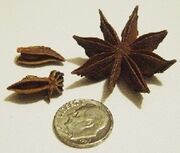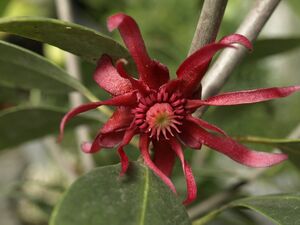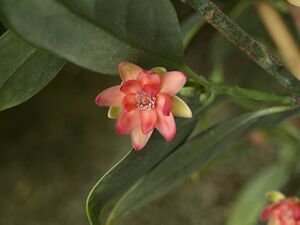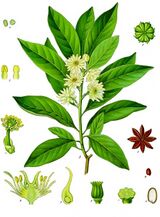الجاذبة
| الجاذبة Illicium | |
|---|---|

| |
| ثمرة الينسون النجمي (Illicium verum) | |
| التصنيف العلمي | |
| مملكة: | |
| Division: | |
| Class: | |
| Order: | |
| Family: | |
| Genus: | Illicium |
| الأنواع | |
|
42 نوع، انظر المقال | |
الجاذبة Illicium أو شجرة الينسون Anise-tree اسم لمجموعة من الشجيرات والأشجار العطرة. ينمو معظم هذه المجموعة مثل الينسون النجمي في آسيا. ويصل ارتفاعها إلى 3م. وهي ذات أوراق عطرة دائمة الخضرة، وسيقان قصيرة، وزهور ذات لون أحمر أرجواني. وتنمو الثمار متجمعة على شكل نجمة. وأحد التوابل المسمى بالينسون النجمي، يتم الحصول عليه من هذه الثمار. ويستخدم لإعطاء نكهة للحلوى والأدوية.</ref> or alternately as the sole genus of the Illiciaceae.[1] It has a disjunct distribution, with most species native إلى شرق آسيا والعديد في أجزاء من أمريكا الشمالية، بما في ذلك جنوب شرق الولايات المتحدة والمكسيك والكاريبي.[2] General common names include star anise[3] and anisetree.[4] The genus name comes from the Latin illicere ("to allure").[3]
. . . . . . . . . . . . . . . . . . . . . . . . . . . . . . . . . . . . . . . . . . . . . . . . . . . . . . . . . . . . . . . . . . . . . . . . . . . . . . . . . . . . . . . . . . . . . . . . . . . . . . . . . . . . . . . . . . . . . . . . . . . . . . . . . . . . . . . . . . . . . . . . . . . . . . . . . . . . . . . . . . . . . . . .
الوصف
Illicium species are evergreen shrubs and small trees. The leaves are alternately arranged and borne on petioles. The blades are glandular and fragrant. The flowers are solitary. They have few to many tepals in two or three rows, the inner ones like petals and the outer ones often smaller and more like bracts. A few to many stamens and pistils are at the center. The fruit is an aggregate of follicles arranged in a star-shaped whorl. One seed is in each follicle, released when the follicle dehisces. The seed has a thick, oily endosperm.[5]
علم الأحياء
These are plants of moist understory, adapted to shady habitat, and some species are so sensitive to light that too much sunlight causes them significant stress, manifesting in chlorosis and necrosis of the leaves.[6]
الاستخدامات
Several species are cultivated as ornamental plants for their flowers, foliage, and fragrance, leading to the development of several cultivars.[7] Many taxa can only be grown in low-light situations.[6]
The essential oils of several species are used as flavorings and carminatives; however, the oils of I. anisatum and I. floridanum are toxic. I. verum, the common star anise, is used to flavor food and wine. Its fruit is a traditional Chinese medicine called pa-chio-hui-hsiang, which is used to treat abdominal pain and vomiting.[5]
التنوع
Illicium is a notably difficult genus to taxonomically classify. Many of the currently recognized species are lack distinguishing characters, and treatments tend to list many synonyms. Additionally, herbarium material is often poorly preserved or scarce.[8]
- Species include
- [9]
- Illicium angustisepalum - S China
- Illicium anisatum – Japan, South Korea, Taiwan
- Illicium arborescens - Taiwan
- Illicium brevistylum - Guangdong, Guangxi, Hunan, Yunnan
- Illicium burmanicum - Yunnan, Myanmar
- Illicium cubense - Cuba
- Illicium difengpi - Guangxi
- Illicium dunnianum - S China
- Illicium ekmanii
- Illicium floridanum- United States (FL GA AL MS LA)[10]
- Illicium griffithii - Tibet, Bhutan, Arunachal Pradesh
- Illicium guajaibonense - Cuba
- Illicium henryi - S China
- Illicium hottense
- Illicium jiadifengpi - S China
- Illicium lanceolatum - S China
- Illicium leiophyllum - Hong Kong
- Illicium macranthum - Yunnan
- Illicium majus - S China, Vietnam, Myanmar
- Illicium merrillianum - Yunnan, Myanmar
- Illicium micranthum - Yunnan
- Illicium modestum - Yunnan
- Illicium pachyphyllum - Guangxi
- Illicium parviflorum – yellow anise - United States (FL GA SC)[11]
- Illicium parvifolium
- Illicium petelotii - Yunnan, Vietnam
- Illicium philippinense - Philippines, Taiwan
- Illicium ridleyanum
- Illicium simonsii - S China, Assam, Myanmar
- Illicium stapfii
- Illicium sumatranum
- Illicium tashiroi - Taiwan, Nansei-shoto
- Illicium tenuifolium - Vietnam
- Illicium ternstroemioides - Fujian, Hainan
- Illicium tsaii - Yunnan
- Illicium verum – star anise, Chinese star-anise, staranise tree - Guangxi
- Illicium wardii - Yunnan, Myanmar
المراجع
- ^ Watson, L. and M. J. Dallwitz. 1992 onwards. Illiciaceae Van Tiegh. The Families of Flowering Plants. Version: 19 August 2013.
- ^ Oh, I. C., et al. (2003). Evolution of Illicium (Illiciaceae): mapping morphological characters on the molecular tree. Plant Systematics and Evolution 240(1-4), 175–209.
- ^ أ ب Illicium. Flora of North America.
- ^ خطأ استشهاد: وسم
<ref>غير صحيح؛ لا نص تم توفيره للمراجع المسماةitis - ^ أ ب Illiciaceae. Flora of North America.
- ^ أ ب Griffin, J. J., et al. (2004). Photosynthesis, chlorophyll fluorescence, and carbohydrate content of Illicium taxa grown under varied irradiance. Journal of the American Society for Horticultural Science 129(1), 46–53.
- ^ Ashburn, D. Illicium belongs in Southern gardens. Archived 2013-09-08 at the Wayback Machine Cooperative Extension. North Carolina State University. 2006.
- ^ Morris, Ashley B.; Bell, Charles D.; Clayton, Joshua W.; Judd, Walter S.; Soltis, Douglas E.; Soltis, Pamela S. (2007). "Phylogeny and Divergence Time Estimation in Illicium with Implications for New World Biogeography". Systematic Botany. 32 (2): 236–249. doi:10.1600/036364407781179734. S2CID 86383852.
- ^ "Illicium L." Plants of the World Online. Board of Trustees of the Royal Botanic Gardens, Kew. 2017. Retrieved 13 March 2021.
- ^ Biota of North America Program 2013 county distribution map, Illicium floridanum
- ^ Biota of North America Program, 2013 county distribution map, Illicium parviflorum



